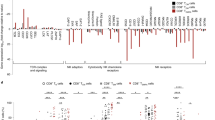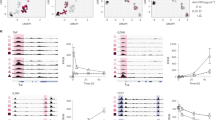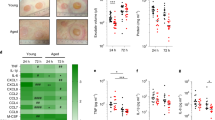Abstract
Mitogen-activated protein kinases (MAPKs) including Erk, Jnk and p38 regulate diverse cellular functions and are thought to be controlled by independent upstream activation cascades. Here we show that the sestrins bind to and coordinate simultaneous Erk, Jnk and p38 MAPK activation in T lymphocytes within a new immune-inhibitory complex (sestrin–MAPK activation complex (sMAC)). Whereas sestrin ablation resulted in broad reconstitution of immune function in stressed T cells, inhibition of individual MAPKs allowed only partial functional recovery. T cells from old humans (>65 years old) or mice (16–20 months old) were more likely to form the sMAC, and disruption of this complex restored antigen-specific functional responses in these cells. Correspondingly, sestrin deficiency or simultaneous inhibition of all three MAPKs enhanced vaccine responsiveness in old mice. Thus, disruption of sMAC provides a foundation for rejuvenating immunity during aging.
This is a preview of subscription content, access via your institution
Access options
Access Nature and 54 other Nature Portfolio journals
Get Nature+, our best-value online-access subscription
$29.99 / 30 days
cancel any time
Subscribe to this journal
Receive 12 print issues and online access
$209.00 per year
only $17.42 per issue
Buy this article
- Purchase on Springer Link
- Instant access to full article PDF
Prices may be subject to local taxes which are calculated during checkout








Similar content being viewed by others
References
Montecino-Rodriguez, E., Berent-Maoz, B. & Dorshkind, K. Causes, consequences, and reversal of immune system aging. J. Clin. Invest. 123, 958–965 (2013).
Dorshkind, K., Montecino-Rodriguez, E. & Signer, R.A.J. The ageing immune system: is it ever too old to become young again? Nat. Rev. Immunol. 9, 57–62 (2009).
Lutz, W., Sanderson, W. & Scherbov, S. The coming acceleration of global population ageing. Nature 451, 716–719 (2008).
Di Mitri, D. et al. Reversible senescence in human CD4+CD45RA+CD27− memory T cells. J. Immunol. 187, 2093–2100 (2011).
Lanna, A., Henson, S.M., Escors, D. & Akbar, A.N. The kinase p38 activated by the metabolic regulator AMPK and scaffold TAB1 drives the senescence of human T cells. Nat. Immunol. 15, 965–972 (2014).
Henson, S.M. et al. p38 signaling inhibits mTORC1-independent autophagy in senescent human CD8+ T cells. J. Clin. Invest. 124, 4004–4016 (2014).
Li, G. et al. Decline in miR-181a expression with age impairs T cell receptor sensitivity by increasing DUSP6 activity. Nat. Med. 18, 1518–1524 (2012).
Müller-Durovic, B. et al. Killer cell lectin-like receptor G1 inhibits NK cell function through activation of adenosine 5′-monophosphate-activated protein kinase. J. Immunol. 197, 2891–2899 (2016).
Akbar, A.N., Henson, S.M. & Lanna, A. Senescence of T lymphocytes: implications for enhancing human immunity. Trends Immunol. 37, 866–876 (2016).
Weng, N.-P., Akbar, A.N. & Goronzy, J. CD28− T cells: their role in the age-associated decline of immune function. Trends Immunol. 30, 306–312 (2009).
Chang, L. & Karin, M. Mammalian MAP kinase signalling cascades. Nature 410, 37–40 (2001).
Johnson, G.L. & Lapadat, R. Mitogen-activated protein kinase pathways mediated by ERK, Jnk, and p38 protein kinases. Science 298, 1911–1912 (2002).
Liu, Y., Shepherd, E.G. & Nelin, L.D. MAPK phosphatases—regulating the immune response. Nat. Rev. Immunol. 7, 202–212 (2007).
Chen, R.E. & Thorner, J. Function and regulation in MAPK signaling pathways: lessons learned from the yeast Saccharomyces cerevisiae. Biochim. Biophys. Acta 1773, 1311–1340 (2007).
Budanov, A.V. et al. Identification of a novel stress-responsive gene Hi95 involved in regulation of cell viability. Oncogene 21, 6017–6031 (2002).
Peeters, H. et al. PA26 is a candidate gene for heterotaxia in humans: identification of a novel PA26-related gene family in human and mouse. Hum. Genet. 112, 573–580 (2003).
Velasco-Miguel, S. et al. PA26, a novel target of the p53 tumor suppressor and member of the GADD family of DNA damage and growth arrest inducible genes. Oncogene 18, 127–137 (1999).
Budanov, A.V. & Karin, M. p53 target genes sestrin1 and sestrin2 connect genotoxic stress and mTOR signaling. Cell 134, 451–460 (2008).
Hardie, D.G., Ross, F.A. & Hawley, S.A. AMPK: a nutrient and energy sensor that maintains energy homeostasis. Nat. Rev. Mol. Cell Biol. 13, 251–262 (2012).
Lee, J.H. et al. Sestrin as a feedback inhibitor of TOR that prevents age-related pathologies. Science 327, 1223–1228 (2010).
Lee, J.H. et al. Maintenance of metabolic homeostasis by Sestrin2 and Sestrin3. Cell Metab. 16, 311–321 (2012).
Lee, J.H., Budanov, A.V. & Karin, M. Sestrins orchestrate cellular metabolism to attenuate aging. Cell Metab. 18, 792–801 (2013).
Parmigiani, A. et al. Sestrins inhibit mTORC1 kinase activation through the GATOR complex. Cell Rep. 9, 1281–1291 (2014).
Peng, M., Yin, N. & Li, M.O. Sestrins function as guanine nucleotide dissociation inhibitors for Rag GTPases to control mTORC1 signaling. Cell 159, 122–133 (2014).
Chantranupong, L. et al. The sestrins interact with GATOR2 to negatively regulate the amino-acid-sensing pathway upstream of mTORC1. Cell Rep. 9, 1–8 (2014).
Yang, Y.-L. et al. SESN-1 is a positive regulator of lifespan in Caenorhabditis elegans. Exp. Gerontol. 48, 371–379 (2013).
Chen, C.C. et al. FoxOs inhibit mTORC1 and activate Akt by inducing the expression of Sestrin3 and Rictor. Dev. Cell 18, 592–604 (2010).
Hay, N. p53 strikes mTORC1 by employing sestrins. Cell Metab. 8, 184–185 (2008).
Göransson, O. et al. Mechanism of action of A-769662, a valuable tool for activation of AMP-activated protein kinase. J. Biol. Chem. 282, 32549–32560 (2007).
Lanna, A. et al. IFN-α inhibits telomerase in human CD8+ T cells by both hTERT downregulation and induction of p38 MAPK signaling. J. Immunol. 191, 3744–3752 (2013).
Oxman, M.N. et al. A vaccine to prevent herpes zoster and postherpetic neuralgia in older adults. N. Engl. J. Med. 352, 2271–2284 (2005).
Levin, M.J. Immune senescence and vaccines to prevent herpes zoster in older persons. Curr. Opin. Immunol. 24, 494–500 (2012).
Oh, J.Z. et al. TLR5-mediated sensing of gut microbiota is necessary for antibody responses to seasonal influenza vaccination. Immunity 41, 478–492 (2014).
Johnson, S.C., Rabinovitch, P.S. & Kaeberlein, M. mTOR is a key modulator of ageing and age-related disease. Nature 493, 338–345 (2013).
Round, J.L. et al. Scaffold protein Dlgh1 coordinates alternative p38 kinase activation, directing T cell receptor signals toward NFAT but not NF-kappaB transcription factors. Nat. Immunol. 8, 154–161 (2007).
Ashwell, J.D. The many paths to p38 mitogen-activated protein kinase activation in the immune system. Nat. Rev. Immunol. 6, 532–540 (2006).
Akbar, A.N. & Henson, S.M. Are senescence and exhaustion intertwined or unrelated processes that compromise immunity? Nat. Rev. Immunol. 11, 289–295 (2011).
Escors, D. et al. Targeting dendritic cell signaling to regulate the response to immunization. Blood 111, 3050–3061 (2008).
Plunkett, F.J. et al. The loss of telomerase activity in highly differentiated CD8+CD28−CD27− T cells is associated with decreased Akt (Ser473) phosphorylation. J. Immunol. 178, 7710–7719 (2007).
Acknowledgements
We thank A. Sewell, D. Mosser and O. Franzese for discussions. Supported by the Wellcome Trust (AZR00630 to A.L.) and the Biotechnology and Biological Science Research Council (BB/L005328/1 to A.N.A.). D.C.O.G. was supported by the Coordination for the Improvement of Higher Education Personnel (CAPES- Brazil) (grant number 99999.006198/2014-07). B.M.-D. was supported by the Swiss National Foundation (P300PB_161092 and P2BSP3_151877); T.M.D. was supported by an NIHR BRC grant; D.E. was supported by a Miguel Servet Fellowship (CP12/03114) and a FIS project (PI14/00579) from the Instituto de Salud Carlos III, Spain. Mouse Sestrin 1 studies were supported by the Ellison Medical Foundation (AG-SS-2440-10 to M.K.) and the NIH (R21AG045432 to J.H.L.). A.L. is a recipient of a Sir Henry Wellcome Trust Fellowship sponsored by M.L. Dustin (University of Oxford).
Author information
Authors and Affiliations
Contributions
A.L. conceived, planned and performed the study, analyzed and interpreted data and wrote the paper; D.C.O.G., B.M.-D. and T.M. performed experiments; D.E. provided lentiviral tools; D.W.G. supported mouse experiments; J.H.L. and M.K. provided Sesn1−/− mice and experimental advice and edited the paper; A.N.A. provided overall guidance, experimental advice and laboratory infrastructure and edited the paper; all authors read and approved the final manuscript.
Corresponding authors
Ethics declarations
Competing interests
A.L. and A.N.A. have filed a patent on ‘modulators of sestrins’ for immunotherapy (filing number PCT/IB2016/057209; filing date 30 November 2016) and are founders and equal shareholders of Rejuviron Ltd., which aims to identify and commercialize the use of sestrin inhibitors to boost immunity during aging.
Integrated supplementary information
Supplementary Figure 1 mTORC1 is nonessential for sestrin function in senescent T cells.
Measurement of (a) sestrin1, (b) sestrin2 or (c) sestrin3 expression by both immunoblots (top) and quantitative PCR (bottom) in senescent CD27- CD28- CD4+ T cells transduced as indicated. Immunoblots are representative of 2 independent experiments. Samples for quantitative PCR were analyzed from 3 different donors and normalized against housekeeping GAPDH. Knockdown efficiency was evaluated 96 hours post-transduction. Results presented relative to those of cells transduced with shCtrl, set as 1. (d) Immunoblots of mTOR and S6K1 expression in cells gated as in Fig. 1b (n = 3). Total ERK, loading control. Sesn3, internal Sestrin control. See also Fig. 1b. (e) Ki-67 (top panel), mTOR expression (middle panel) and p-S6K1 (bottom panel) in senescent CD4+ T cells transduced as indicated, then examined by phospho-flow 96h later. Representative overlay (left) and pooled data (right; n=3) are shown. Results presented relative to those of cells transduced with shCtrl, set as 1. (f) Effectiveness of the mTOR inhibitor rapamycin (20 ng/mL) in cells as in (e). (g) Calcium abundance, (h) IL2, (i) telomerase activity and (j) γ-H2Ax phosphorylation in CD27- CD28- CD4+ T cells transduced as indicated then treated with rapamycin for 18h, presented as above. *p<0.05 **p<0.01 and ***p< 0.001 values were assessed by a paired Student’s t test (a-c) or ANOVA for repeated measures with a Bonferroni post-test correction (d-j). Errors bars depict s.e.m.
Supplementary Figure 2 Sestrins as noncanonical regulator of MAPK function.
(a) Immunoblot analysis of lysates from senescent CD27- CD28- CD4+ T cells after immunoprecipitation with sestrin2 or IgG control antibodies. (b) Phospho-flow analysis of Erk, Jnk and p38 MAPK phosphorylation in cells as in Figure 1b. Pooled results (n = 4) presented relative to those of nonsenescent CD27+ CD28+ CD4+ T cells, set as 1. (c) Immunoblots of endogenous MKK7, MKK4 and p-MEK1/2 in cells as in (b). Total AMPK, loading control. Immunoblots representative of 3 independent experiments. (d) Validation of indicated siRNAs in primary human CD4+ T cells by flow-cytometry. Data (n = 2) presented relative to those cells transfected with control siRNA, set as 1. (e) MAPK signaling in nonsenescent versus senescent CD4+ T cells transfected with the indicated siRNAs, followed by phospho-flow analysis 48h later. Pooled data (n = 3) presented relative to those of cells transfected with control siRNA, set as 1. (f) In vitro kinase assays in sestrin2 immunoprecipitates from senescent CD4+ T cells transduced as indicated and studied 96h later. See also Figure 2. *p<0.05 **p<0.01 and ***p< 0.001 values were assessed by ANOVA for repeated measures with a Bonferroni post-test correction (c) or a paired Student’s t test (e-f). Errors bars depict s.e.m.
Supplementary Figure 3 Sestrins are essential for stress-sensing in T cells.
(a) Overlay and (b) pooled data (n = 3) of sestrin protein expression in nonsenescent CD27+ CD28+ CD4+ T cells 8 hours after X-ray irradiation (8 Gy/min, 10’), assessed by intracellular-specific flow cytometry. (c) Telomerase activity and (d) IL-2 in cells as in (b). (e) DDR signaling in cells as in (c-d). Results presented as relative to those of Sestrin-proficient (Ctrl) cells before irradiation, set as 1. Data are representative of two experiments with two individual donors (a, b) or three experiments with three different donors (c, d, e). **p<0.01 and ***p< 0.001 values were assessed by ANOVA for repeated measures with a Bonferroni post-test correction. Errors bars depict s.e.m.
Supplementary Figure 4 Nonoverlapping functional spectra by sestrin-responsive MAPKs.
(a) Measurement of MAPK activity by in vitro kinase assays in sestrin1 complexes from senescent CD4+T cells cultured with the indicated MAPK inhibitors for 48h as indicated, and presented relative to those of DMSO control-treated cells, set as 1 (n = 4). (b) Proliferation of cells as in (a), stimulated with anti-CD3 and rhIL2 for 36 h. (c) MAPK inhibition by siRNAs, assessed by both immunoblotting (top) and quantitative PCR (bottom) 48h post-transfection. (d) Effects (top) and selectivity (bottom) of the indicated siRNAs on senescent CD4+ T cell function. Pooled data (n = 3) presented relative to those of cells treated with control siRNA, set as 1. (e) AMPK activity in AMPK-γ immunoprecipitates from senescent CD4+ T cells transduced as indicated. Extracts were washed, incubated with either AMP (150 μM) or A-769662 (150 μM) for 30’ and AMPK activity was determined by in vitro kinase assays. Data (n = 3) presented relative to those of cells transduced with shCtrl and not treated with either AMP or A-769662, set as 1. (f) Senescent CD4+ T cells transduced as indicated were reactivated with the AMPK agonist A-769662 (150 μM) and MAPK inhibitors for 48 hours, followed by measurement of telomerase activity, γ-H2AX phosphorylation and calcium flux. Results (n = 3) presented relative to those of cells transduced with shCtrl, set as 1. In (a) a paired Student’s t test. In (b, d, e, f) ANOVA for repeated measures with a Bonferroni post-test correction.**p<0.01 and ***p< 0.001. Errors bars depict s.e.m.
Supplementary Figure 5 Sestrin inhibition enhances antigen-specific functions in old T cells.
Senescent CD4+ T cells from old humans (70-85 years) were transduced as indicated, rested for 10 days, then challenged with autologous antigen presenting cells (APCs) pre-oaded with the indicated CMV antigen dilutions. After additional 3 days (a) proliferation and (b) cytokine production was examined by flow-cytometry (n = 3). Antigen-specific proliferation data presented relative to those of cells transduced with shCtrl, and stimulated with the lowest CMV antigen dilution (1:50), set as 1.
Supplementary Figure 6 Immuno-expansion in old Sesn1–/– mice upon vaccination.
(a) Expression of sestrin proteins among CD4+ T cells from young (2 months) or old (20 months) mice assessed by intracellular specific flow-cytometry. Age-dependent expression of Sestrin presented relative to that of young mouse CD4+ T cells, set as 1 (n = 3). (b) Measurement of mouse Sesn1 by both immunoblotting (left) and real-time PCR (right) in splenocytes of indicated genotypes (age: 20 months). Data representative or pooled from 3 separate mice. (c) Spleens from Sesn+/- and Sesn1-/- null mice 5 days after vaccination with FLUAD (1:20 of the human dose). Frequencies of (d) CD4+/ CD8+ T cells (e) myeloid and (f) NK cells in Sesn1+/- and Sesn1-/- mice after vaccination as in (c). (g) Effector/naïve phenotype of CD4+ T cells in control Sesn1-/+ and Sesn1-/- null mice, five days after vaccination with FLUAD. (h) FLUAD-driven IgG isotypic switch in Sesn+/- and Sesn1-/- CD19+ B cells examined by flow-cytometry. (i) Cumulative pre and postvaccination immune-phenotypes of 20-month old control Sesn1+/- and Sesn1-/- null mice. Data (4 old mice per group) presented relative to those of unvaccinated control Sesn1+/-, set as 1. ***p<0.001, ANOVA with Bonferroni post-correction test for comparisons. Error bars depict s.e.m.
Supplementary Figure 7 In vivo MAPKi suppresses immune function in sestrin-negative cells.
(a) Phospho-flow of Erk, Jnk and p38 phosphorylation in CD4+ T cells from control Sesn1+/- and Sesn1-/- null mice 5 days after vaccination with FLUAD. Data presented relative to those of control Sesn1+/-, set as 1. (b) Spleens of 16-month old mice vaccinated with FLAUD and daily kept on Erk, Jnk and p38 MAPK inhibitors or all three inhibitors together (triple MAPKi). DMSO, vehicle control. (c) Impact of MAPKi on immune-responsiveness of sestrin2- CD4+ T and CD19+ B cells to vaccination with FLAUD in vivo, presented relative to DMSO-injected (control) mice, set as 1 (n = 4). ***p< 0.001, ANOVA with Bonferroni post-test correction. Error bars depict s.e.m.
Supplementary information
Supplementary Text and Figures
Supplementary Figures 1–10 (PDF 1884 kb)
Rights and permissions
About this article
Cite this article
Lanna, A., Gomes, D., Muller-Durovic, B. et al. A sestrin-dependent Erk–Jnk–p38 MAPK activation complex inhibits immunity during aging. Nat Immunol 18, 354–363 (2017). https://doi.org/10.1038/ni.3665
Received:
Accepted:
Published:
Issue Date:
DOI: https://doi.org/10.1038/ni.3665



